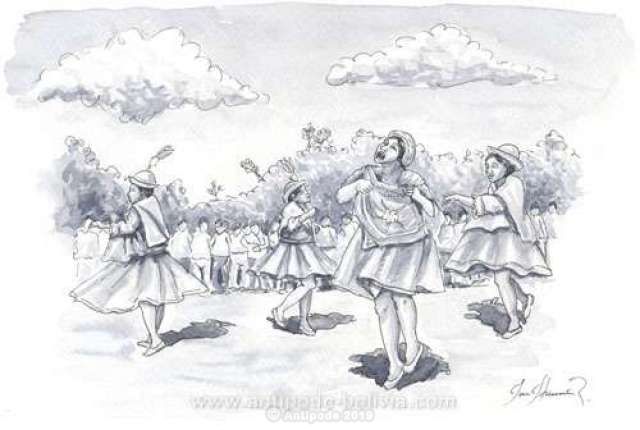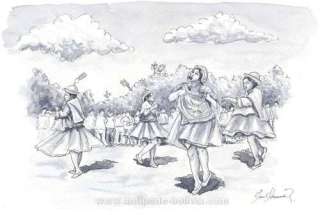

Celebrations and festivities in Bolivia
Celebrations and festivities: some dates
January:
- In La Paz, Alasitas
feria stands in honor of
the Aymara god Ekeko, God of abundance. Thousands of handmade products are
exposed and serve as miniature representations of all the dreams you want to
see become true, all the goods we wish to have during the year. This
celebration is an indispensable element of the Andean culture.
- On January 6th, ‘’dia de los Reyes’’, epiphany
is celebrated in the countrywide, and especially in Sucre, Tarija, Cochabamba,
Potosi and villages around Oruro, where dances and festivities are full of
colors.
February:
- On February 2nde, the celebration of Virgen de la Candelaria adorns folk music
and dances, peregrinations and in Copacabana, they bless and baptize cars, in
Samaipata and Aiquile (near to Cochabamba), agitated masses are full of people.
- In Potosi, for the Virgen celebration (variable date),
minors go down to the mine in procession, sporting the picture of the Mines
Patron.
- On February 10th, Oruro welcomes its famous carnival,
where music, costumes, dances, celebrations of all kinds invade the city and
exhibitions of handicraft are presented.
February-March:
During the week before Lent, many cities like Tarija, Oruro,
Santa Cruz, Vallegrande, etc… celebrate their annual carnival, with fanfares,
processions, dances…
March:
- On the second Sunday of March, Tarabuco celebrates Quechua deads who tried to ward off Spanish
troupes in 1816. Once again, animated and colored festivities.
- On March 19th, San Ignacio (Jesuit missions)
celebrates St. Joseph, with traditional dances from indigenous peoples
of the region, two-meter panpipes carried by two men, giant heads in procession…
On March 21th, the entire region of rural Andes celebrates spring solstice, with
offerings to Pachamama.
April :
- Holy Week, Easter and its religious fervor; throughout the
country, this is a very impressive celebration. Good Friday is particularly
wonderful in Copacabana, where a massive pilgrimage from La Paz overwhelms the
entire city.
-On April 15th, popular celebrations in Tarija for the
Ephemerides, with parades and dances.
May:
- On May 3rd, a celebration of the Señor Vera Cruz Tatala in
Potosi, when during the four week-ends before the celebration,
there are festivities, pilgrimage to holy places, colored processions…
- On May 8th, always in Potosi, they celebrate markets with
processions covered of silver.
- The Feast of the Cross (Christ’s cross
for Christians and the cross of the south for pagans) is very animated in
Tarija, where during two weeks, intense music is delighting the city. It is
also very beautiful in Vallegrande, Cochabamba and Copacabana.
- Also, during this month, La Paz celebrates the Gran
Poder, and Oruro resurrects its carnival.
June:
- On June 21sh, the winter solstice is celebrated in Tiwanaku (region
of La Paz) and they venerate the Solar God; Inti.
- On June 24th, Saint Jean-Baptiste Day (Juan Bautista) animates
the entire country, and fireworks, bonfires and dances are performing.
This celebration is particularly exceptional in Santa Cruz.
-Also on June 24th, in Potosi, there is the celebration of Ch’utillo,
old Spanish tradition representing good triumphing over evil (Satan would have gone
down from the mines till the city and Saint Bartholomew would have beaten him).
A gigantic procession gathers to remember the event, colored, animated, with
music and dances, in short, another wonderful festivity.
-On June 29th, Titicaca Lake receives Saint Peter and
Saint Pau. Crossings of the lake, swimming or in boat, dances, festivities.
August:
- On the first of August, the entire country celebrates
Pachamama, the Mother Earth. They give offerings and sometimes, there
are sacrifices of small animals or even lamas, in order to thank for the good
harvest of the year and to beg her to continue offering her favors to Humans.
- In La Paz, at the beginning of August, the Academic Carnival
sees parading its students, who dance wearing traditional costumes of the
region.
- On the 5th, Copacabana comes back to celebrate the
Virgen, with pre-Hispanic Pagan dances and religious Christian ceremonies.
- On August 6th, this is the Bolivian national day, the
independence day (like
July 14th for French people, July 4th for American
people…). Once more, Copacabana is worse to see at this period but in
reality, all the country welcomes a moment of unrestrained celebration.
- On August 10th, Tarija celebrates San Lorenzo: this
is one of the most authentic celebration of the South of Bolivia, nicknamed the
Andalusian.
- On August 15th, the Assumption Day, Cochabamba’s
region celebrates the Urkupiña in Quillacolla; 500 000 persons hit the road of
the annual pilgrimage.
- On August 24th, in Potosi, they celebrate Ch’utillo;
less agitated and less exaggerated than others, this celebration is absolutely splendid.
September:
- On the first Sunday of this month, Tarija goes back
to the hill to celebrate San Roque, and the « Matacos » and dancers of
Chaco’s region animate the city during all the night.
October:
- The celebration of the Virgen del Rosario
is
a basic in the countrywide. It is also the month when potatoes, and Pagan
beliefs from the Altiplano celebrate a lot of ceremonies and offerings to the miraculous
tuber of these cold and arid regions.
- The Flower Festival in Tarija, on the
second Sunday of this month, announces the spring and repeats, to a certain
extent, the San Roque celebration.
November:
- All Saint’s Day, first of November, is also
called in Bolivia « Dia de los Muertos » or « Dia de los Santos »’ (as
you like) : it is usual to prepare your family members’ favorite dishes,
as well as small sweetbreads they bring to the cemetery, in memory and offering
to deceased loved ones.
December:
- During Christmas, all Bolivia is preparing
for the religious midnight ceremony, and eat the Piquana, Bolivian Christmas dish.



